Recent developments in Africa related to the contentious topic of homosexuality have reminded me of a discussion that took place during one of the interactive sessions at CPD’s 2013 Summer Institute in Public Diplomacy....
KEEP READINGThe CPD Blog is intended to stimulate dialog among scholars and practitioners from around the world in the public diplomacy sphere. The opinions represented here are the authors' own and do not necessarily reflect CPD's views. For blogger guidelines, click here.
India Blog Series: Glorious Delhi: A Melting Pot For Religious Diplomacy
APDS Blogger: Hend Alhinnawi
NEW DELHI --- Walking through the streets of New Delhi, it is hard to resist the city’s unique combination of old charm and modern features. Whether you’re looking for cultural, social, or religious diversity, you're sure to find it in New Delhi. On December 12, 2011, New Delhi celebrated its 100th year as India’s “spanking new capital.” On that same day in 1931, King George V announced the shifting of the India’s capital from Calcutta to Delhi. So, what makes New Delhi so special? For one, there are many religions represented including Hinduism, Islam, Sikhism, Buddhism, Jainism, the Baha’i faith, and Christianity. One day, our group visited Askhardham, Jama Masjid, and the Lotus Temple-- all sites with magnificent structural appeal and a story to tell.
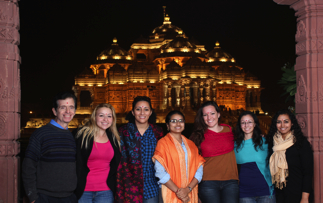
Our first stop, Akshardham, is located in the heart of New Delhi and represents 10,000 years of Indian culture that is showcased through breathtaking gardens, structures, and artwork. The Swaminarayan Akshardham embodies Indian culture, art, wisdom, heritage, and values, and serves as a tribute to Bhagwan Swaminarayan (1781-1830). It is an enlightening journey through India’s values and contributions for the progress, happiness, and harmony of humanity.. The temple was built in five years, and was inaugurated on November 6, 2005, with the blessings of His Divine Holiness, Pramukh Swami Maharaj of the Bochasanwasi Shri Akshar Purushottam Swaminarayan Sanstha (BAPS). The term Akshardham refers to the eternal, divine abode of the supreme God, eternal values, and the virtues of Akshar as defined in the Vedas and Upanishads where divine bhakti, purity, and peace forever pervades. However, Akshardham is much more than a place of worship. It provides a space where Indian and non-Indian visitors can learn more about India’s history, cultural heritage, achievements, inventions, and scientific contributions. It is a powerful public diplomacy tool because it tells a story that people from different faiths and backgrounds can relate to and understand.. As an individual learning about this particular Hindu sect for the first time, I left Akshardham with a greater understanding and appreciation for the religion, and was able to relate many of the core concepts to my own faith.
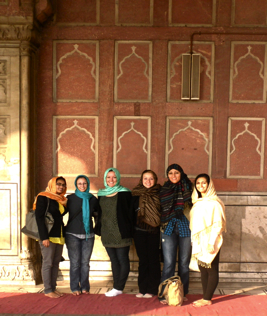
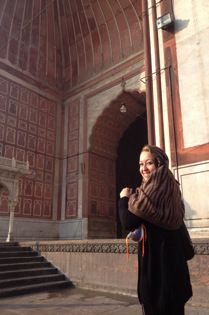
Next, we visited Jama Masjid in Old Delhi, the largest mosque in India. It was built between 1644 and 1658, and is one of the last architectural works done by Mughal emperor Shah Jahan. The mosque has a grand entrance and was built using red sandstones and marble. It has the potential to hold thousands at one time. Originally, it was called the Masjid-i-Jahan-Numa, which means mosque commanding view of the world. Our group, covered with shawls, walked around Jama Masjid admiring the views, magnificent arches and prayer halls. The Masjid stands at the center of the capital city of the Mughals, Shahjahanbad, now Delhi. Jama Masjid has three gateways with verses from the holy Quran inscribed in its walls. For Muslims, the second largest religious population in India, this mosque is particularly significant because it houses a cabinet which contains a collection of the Prophet Mohammad’s (PBUH) relics, including a red beard-hair of the prophet, the Quran written on deerskin, and his sandals and footprints, implanted in a marble block. For individuals wanting to learn more about Islam, or for Muslims looking for a place to worship, Jama Masjid provides a welcoming environment for both. Although it is located in the middle of a busy Old Delhi market place, once you enter the mosque, there is a certain serenity that overcomes the insanity outside. Individuals from all faiths can pray or meditate in the mosque’s spacious courtyard overlooking Old Delhi.
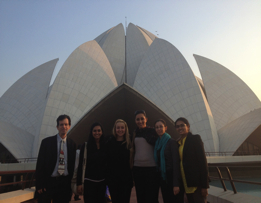
Finally, our group made the journey to the Lotus Temple. Symbolizing peace, and surrounded by gardens, this temple represents the Bahai faith and was completed in 1986. It stands at more than 40 Meters in height, and its distinct features are 27 giant white petals of white marble in a lotus shape. The central theme of the Bahai faith is unity through diversity, and a great emphasis is placed on prayer and meditation. Once our group entered the temple, we sat in a large prayer hall where we meditated and reflected for a few minutes before exploring the temple. Bahai’s believe that prayer and meditation is important to the progress of the human soul, both in this world and the next. There are more than two million Bahai’s living in India and representing the diverse regions all over the country.
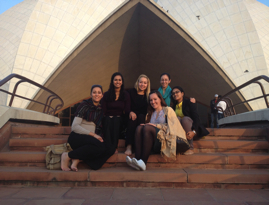
In my opinion, the spiritual diversity is what unites New Delhi and is one of its main attractions. Combined with its vast history, rich culture and people representing many faiths, New Delhi gives new meaning to faith diplomacy. The presence of these different religions and their ability to exist harmoniously in the same space speaks volumes about the people of India, and their tolerance and acceptance for diversity. From a public diplomacy perspective, religious institutions, such as Akshardham, Jama Masjid, and the Lotus Temple, are great tools that help build mutual understanding and mediate conflicts because they provide a space where individuals can learn about the respective religion, and interact with its followers, hence breaking the cycle of fear and ignorance.
Hend Alhinnawi is a graduate student working on her professional Master's of Public Diplomacy at USC. In the past, she worked with the United Nations and AMIDEAST in the Middle East and Africa on international development and resource mobilization related issues. She is also participating in the India:Inside Out Project.
Visit CPD's Online Library
Explore CPD's vast online database featuring the latest books, articles, speeches and information on international organizations dedicated to public diplomacy.
POPULAR ARTICLES
-
March 22
-
April 1
-
April 11
-
March 4
-
April 18
Join the Conversation
Interested in contributing to the CPD Blog? We welcome your posts. Read our guidelines and find out how you can submit blogs and photo essays >.













